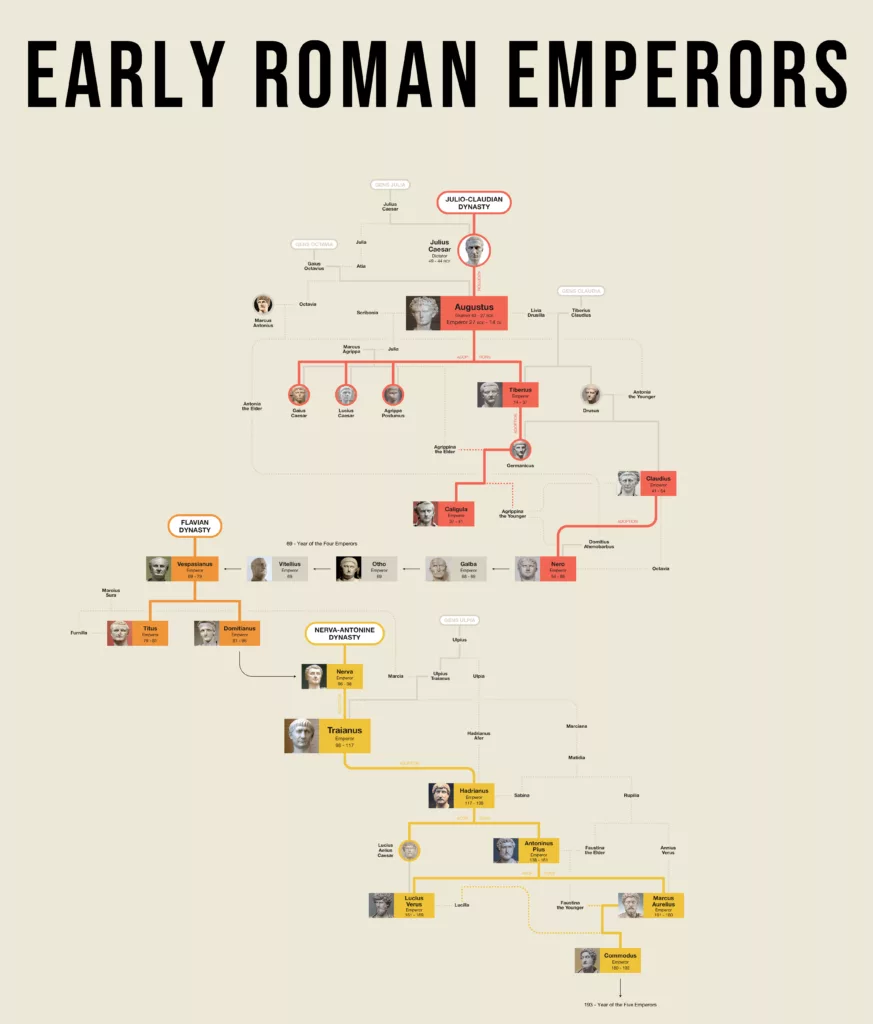The story of the Early Roman Emperors begins with the fall of the Roman Republic and the rise of imperial rule — a transformation that shaped the course of Western civilization for centuries. The family tree of these early emperors, as shown in this chart, traces the evolution of Roman leadership from Julius Caesar to Commodus, spanning the Julio-Claudian, Flavian, and Nerva-Antonine Dynasties.

1. The Julio-Claudian Dynasty (27 BC – 68 AD)
The Julio-Claudian Dynasty marks the foundation of the Roman Empire. This line of rulers descended from or was connected to Julius Caesar and Augustus, Rome’s first emperor.
Julius Caesar (100–44 BC)
Although never officially titled emperor, Gaius Julius Caesar laid the groundwork for imperial Rome. His rise to power ended the Roman Republic, but his assassination in 44 BC opened the door for his heir and grandnephew, Octavian (later Augustus).
Augustus (27 BC – 14 AD)
Augustus, born Octavian, became the first Roman Emperor in 27 BC after defeating Mark Antony and Cleopatra. His reign brought peace and stability through the Pax Romana, and he established the empire’s administrative foundations.
Tiberius (14–37 AD)
Augustus’s stepson, Tiberius, succeeded him. Though a capable administrator, his later years were marked by isolation and paranoia, with growing influence from the Praetorian Guard.
Caligula (37–41 AD)
Gaius Caesar, known as Caligula, was Tiberius’s grandnephew. Initially popular, his reign turned tyrannical and erratic, leading to his assassination after just four years.
Claudius (41–54 AD)
After Caligula’s death, Claudius, his uncle, became emperor. Despite being seen as physically weak, Claudius proved an effective ruler, expanding the empire into Britain and reforming the imperial bureaucracy.
Nero (54–68 AD)
Nero, the last Julio-Claudian emperor, was infamous for his extravagance and alleged cruelty. His rule ended in chaos and rebellion, and his suicide in 68 AD brought the dynasty to an end.
2. The Flavian Dynasty (69–96 AD)
After Nero’s death, Rome plunged into the Year of the Four Emperors (69 AD), with Galba, Otho, and Vitellius briefly ruling before the rise of Vespasian, founder of the Flavian line.
Vespasian (69–79 AD)
Vespasian restored order after civil war and began construction of the Colosseum, symbolizing Rome’s resurgence. His practical leadership reestablished financial and political stability.
Titus (79–81 AD)
Vespasian’s son, Titus, succeeded him and is remembered for compassionately leading Rome during disasters, including the eruption of Mount Vesuvius in 79 AD and a great fire in Rome.
Domitian (81–96 AD)
The last Flavian emperor, Domitian, strengthened imperial authority but ruled autocratically. His assassination in 96 AD ended the dynasty, paving the way for a new era of adoptive succession.
3. The Nerva–Antonine Dynasty (96–192 AD)
Known as the Golden Age of Rome, this period featured emperors chosen for merit rather than bloodline. The dynasty produced some of Rome’s greatest rulers, leading to unprecedented peace, prosperity, and expansion.
Nerva (96–98 AD)
Nerva became emperor after Domitian’s death and introduced the system of adoptive succession, ensuring stability by adopting capable successors.
Trajan (98–117 AD)
Trajan, adopted by Nerva, expanded the empire to its greatest territorial extent, conquering Dacia and parts of the Middle East. His reign was marked by monumental building projects, including Trajan’s Forum and Column.
Hadrian (117–138 AD)
Hadrian, Trajan’s adopted heir, consolidated the empire’s borders, constructing Hadrian’s Wall in Britain. He promoted art, architecture, and legal reforms, shaping the empire’s cultural identity.
Antoninus Pius (138–161 AD)
Antoninus Pius ruled peacefully and justly, maintaining prosperity across the empire. His era saw few wars and great internal stability.
Marcus Aurelius (161–180 AD)
Known as the Philosopher Emperor, Marcus Aurelius ruled with wisdom inspired by Stoic philosophy. His reign, however, faced wars and plagues that tested Rome’s resilience.
Commodus (180–192 AD)
Marcus Aurelius’s son, Commodus, marked the decline of Rome’s golden era. His erratic behavior, self-indulgence, and desire to be worshiped as a god led to his assassination, ending the Nerva–Antonine Dynasty.
Legacy of the Early Roman Emperors
The early emperors — from Augustus to Commodus — transformed Rome from a republic into a vast empire that would dominate the ancient world for centuries. Their legacies, whether of glory or infamy, shaped Roman governance, architecture, and culture. This family tree encapsulates nearly 250 years of imperial history — a saga of ambition, conquest, wisdom, and downfall that still fascinates historians today.



